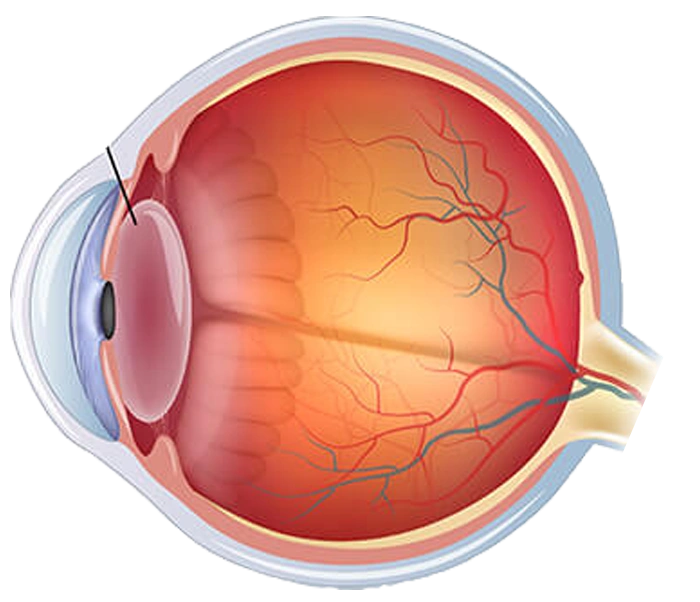Introduction
Cataracts are one of the most common eye problems among the elderly, leading to decreased visual clarity. This condition gradually causes clouding of the eye’s lens, impairing its ability to transmit light to the retina. Cataracts usually develop naturally with aging, but several factors can increase the risk of developing the condition. Since cataracts can significantly affect quality of life, early diagnosis and appropriate treatment are of particular importance. This article explores the symptoms, causes, diagnosis, treatment, and prognosis of cataracts.
Structure and Function of the Eye Lens
The lens is a transparent, oval-shaped structure located at the front of the eye. Its primary role is to focus light onto the retina. Composed of proteins and water, the lens’s flexibility allows the eye to clearly view objects at various distances. When a cataract forms, this transparency is reduced, and light cannot properly reach the retina, leading to vision impairment.
Definition of Cataract
A cataract is an eye disease where the lens gradually becomes cloudy, resulting in decreased vision. It commonly appears after the age of 60 but may also occur earlier due to factors such as specific diseases or eye trauma. Cataracts may develop in one or both eyes, though the severity can differ between them.
Prevalence and Epidemiology
Prevalence:
Cataracts are among the most common visual impairments in older adults. It is estimated that over 50% of people over 60 have some degree of cataracts.
Age:
This disease typically occurs in individuals over 60, although it may also appear in younger people due to various factors.
Geography:
Cataracts are more prevalent in developed countries due to longer life expectancy and better access to healthcare compared to developing countries.
Causes and Risk Factors
The main cause of cataracts is the gradual clouding of the lens, often due to natural aging. However, several factors can increase the risk:
- Aging:
With age, the proteins in the lens change, which reduces its clarity. - Family History:
Individuals with a family history of cataracts are at a higher risk. - Diabetes:
Diabetes can cause changes in the lens, increasing the risk of cataracts. - UV Exposure:
Prolonged exposure to sunlight without protective eyewear can raise the risk. - Certain Medications:
Long-term use of medications such as steroids can increase the likelihood of developing cataracts.
Clinical Symptoms
In the early stages, cataracts may not show significant symptoms. However, as the disease progresses, symptoms can include:
- Gradual Vision Loss:
Blurred vision, especially at night or in low-light conditions. - Light Sensitivity:
Increased sensitivity to bright lights like sunlight or headlights. - Double Vision:
In some cases, cataracts may cause double vision in one eye. - Color Changes:
Colors may appear faded or yellowish. - Night Driving Difficulties:
Impaired night vision or trouble driving in dim lighting.
Diagnosis of Cataracts
To diagnose cataracts, doctors use various methods, including:
- Eye Examination:
Evaluates the health and condition of the lens, pupil response to light, and internal eye structure. - Vision Test:
Measures visual acuity using charts and lens clarity testing. - Contrast Sensitivity Test:
Assesses the eye’s ability to distinguish between light and dark areas. - Ocular Biometry:
For surgical candidates, accurate eye measurements are performed.
Treatment of Cataracts
Cataract treatment is primarily surgical. In the early stages, if symptoms are mild, doctors may recommend special eyeglasses. However, when vision is significantly affected, surgery is the main treatment.
- Cataract Surgery:
The most common treatment, in which the clouded lens is removed and replaced with an artificial lens. This is typically an outpatient procedure, and patients can quickly resume daily activities. - Eyeglasses or Contact Lenses:
May be prescribed in early stages to improve vision.
Conclusion
Cataracts are one of the most common eye diseases, typically occurring with age but also possible in younger individuals. Treatment is mainly surgical, and with early diagnosis and timely intervention, vision can be restored. Regular eye care and consultation with a specialist can help prevent disease progression and improve quality of life.
Nutrition and Diet for Patients After Cataract Surgery
Although cataract surgery is typically an outpatient procedure that doesn’t require intensive aftercare, proper nutrition plays a vital role in promoting recovery and preventing complications. The right diet can boost the immune system, speed up healing, and reduce inflammation. Below are some nutritional recommendations for patients following cataract surgery:
Foods Rich in Antioxidants
Antioxidants, especially vitamins C and E, help reduce inflammation and protect the eyes after surgery by neutralizing harmful free radicals.
- Vitamin C:
Supports tissue repair and healing. Rich sources include citrus fruits (oranges, lemons, grapefruit), bell peppers, strawberries, kiwis, and vegetables like broccoli. - Vitamin E:
Protects cells and tissues from damage. Found in almonds, hazelnuts, sunflower seeds, and plant oils such as olive oil.
Zinc-Rich Foods
Zinc is essential for tissue repair and immune support. It helps accelerate wound healing after surgery.
- Good sources: red meat, poultry, seafood (especially shellfish and fish), beans, lentils, eggs, and nuts (like pistachios and almonds).
Omega-3 Fatty Acids
Omega-3s reduce inflammation and support eye health. They may help in both post-surgical recovery and prevention of future eye problems.
- Sources include: fatty fish (salmon, tuna, sardines), chia seeds, flaxseeds, and walnuts.
Adequate Fluid Intake
Staying hydrated supports detoxification and prevents dry or irritated eyes post-surgery. Avoid caffeinated and alcoholic beverages as they can dehydrate the body and eyes.
- Best options: water, natural juices (without added sugar), and soups.
Anti-Inflammatory Foods
Post-surgical inflammation is common. Anti-inflammatory foods help reduce swelling and speed recovery.
- Examples: turmeric (contains curcumin), ginger, garlic, red berries, and leafy greens like spinach and kale.
Vitamin D
Vitamin D supports overall health and plays a role in immune and inflammatory processes. Adequate intake can prevent post-surgical issues and support healing.
- Sources: fatty fish, eggs, vitamin D-fortified dairy products, and sunlight exposure.
Fiber Intake
Recovery may involve reduced physical activity, which can lead to constipation. High-fiber foods help maintain digestion.
- Sources: whole grains, fruits, vegetables, and legumes like beans and lentils.
Avoid Processed Foods and Unhealthy Fats
Processed foods, trans fats, and added sugars can hinder recovery and promote inflammation. These should be avoided.
Limit Salt Intake
Excess salt can lead to swelling and increased eye pressure, which is not suitable for post-cataract surgery patients.
Final Conclusion
Proper nutrition after cataract surgery not only accelerates healing but also strengthens the immune system and reduces inflammation. A balanced, healthy diet rich in vitamins, minerals, omega-3 fatty acids, and antioxidants positively impacts eye health and helps prevent future problems. Thus, following a well-planned diet during recovery is essential.


















